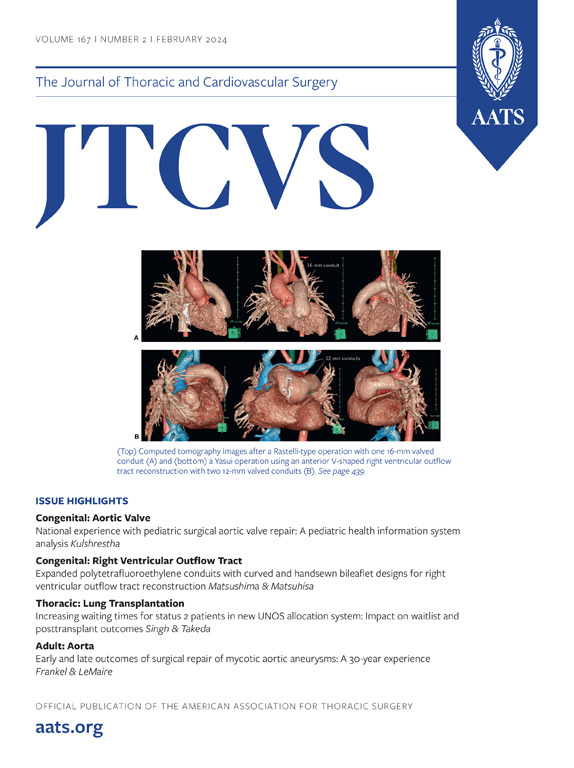Identifying and mitigating risk of postcardiotomy cardiogenic shock in patients with ischemic and nonischemic cardiomyopathy
IF 4.9
1区 医学
Q1 CARDIAC & CARDIOVASCULAR SYSTEMS
Journal of Thoracic and Cardiovascular Surgery
Pub Date : 2024-11-01
DOI:10.1016/j.jtcvs.2024.02.025
引用次数: 0
Abstract
Objectives
To identify preoperative predictors of postcardiotomy cardiogenic shock in patients with ischemic and nonischemic cardiomyopathy and evaluate trajectory of postoperative ventricular function.
Methods
From January 2017 to January 2020, 238 patients with ejection fraction <30% (206/238) or 30% to 34% with at least moderately severe mitral regurgitation (32/238) underwent conventional cardiac surgery at Cleveland Clinic, 125 with ischemic and 113 with nonischemic cardiomyopathy. Preoperative ejection fraction was 25 ± 4.5%. The primary outcome was postcardiotomy cardiogenic shock, defined as need for microaxial temporary left ventricular assist device, extracorporeal membrane oxygenation, or vasoactive-inotropic score >25. RandomForestSRC was used to identify its predictors.
Results
Postcardiotomy cardiogenic shock occurred in 27% (65/238). Pulmonary artery pulsatility index <3.5 and pulmonary capillary wedge pressure >19 mm Hg were the most important factors predictive of postcardiotomy cardiogenic shock in ischemic cardiomyopathy. Cardiac index <2.2 L·min−1 m−2 and pulmonary capillary wedge pressure >21 mm Hg were the most important predictive factors in nonischemic cardiomyopathy. Operative mortality was 1.7%. Ejection fraction at 12 months after surgery increased to 39% (confidence interval, 35-40%) in the ischemic group and 37% (confidence interval, 35-38%) in the nonischemic cardiomyopathy group.
Conclusions
Predictors of postcardiotomy cardiogenic shock were different in ischemic and nonischemic cardiomyopathy. Right heart dysfunction, indicated by low pulmonary artery pulsatility index, was the most important predictor in ischemic cardiomyopathy, whereas greater degree of cardiac decompensation was the most important in nonischemic cardiomyopathy. Therefore, preoperative right heart catheterization will help identify patients with low ejection fraction who are at greater risk of postcardiotomy cardiogenic shock.
识别和降低缺血性和非缺血性心肌病患者开胸手术后心源性休克的风险。
目的确定缺血性和非缺血性心肌病患者开胸手术后心源性休克的术前预测因素,并评估术后心室功能的变化轨迹:方法:2017年1月至2020年1月,238例射血分数为25.0%的患者接受了心肌切除术。采用RandomForestSRC确定其预测因素:结果:27%的患者(65/238)发生了开胸手术后心源性休克。肺动脉搏动指数 19 mmHg 是预测缺血性心肌病患者心肌梗死术后心源性休克的最重要因素。心脏指数-1∙m-2和肺毛细血管楔压>21 mmHg是非缺血性心肌病最重要的预测因素。手术死亡率为1.7%。缺血性心肌病组术后12个月的射血分数增至39%(CI:35-40),非缺血性心肌病组增至37%(CI:35-38):缺血性心肌病和非缺血性心肌病的心肌梗死术后心源性休克的预测因素不同。肺动脉搏动指数低所显示的右心功能不全是缺血性心肌病最重要的预测因素,而心脏失代偿程度越大则是非缺血性心肌病最重要的预测因素。因此,术前右心导管检查将有助于识别射血分数较低、发生开胸术后心源性休克风险较高的患者。
本文章由计算机程序翻译,如有差异,请以英文原文为准。
求助全文
约1分钟内获得全文
求助全文
来源期刊
CiteScore
11.20
自引率
10.00%
发文量
1079
审稿时长
68 days
期刊介绍:
The Journal of Thoracic and Cardiovascular Surgery presents original, peer-reviewed articles on diseases of the heart, great vessels, lungs and thorax with emphasis on surgical interventions. An official publication of The American Association for Thoracic Surgery and The Western Thoracic Surgical Association, the Journal focuses on techniques and developments in acquired cardiac surgery, congenital cardiac repair, thoracic procedures, heart and lung transplantation, mechanical circulatory support and other procedures.

 求助内容:
求助内容: 应助结果提醒方式:
应助结果提醒方式:


